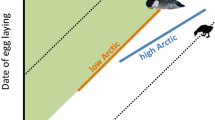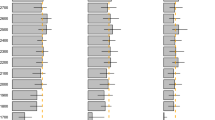Abstract
Migratory birds often travel long distances between non-breeding and breeding areas. The suitability of weather and foraging conditions they experience upon arrival at their breeding grounds is an essential component explaining the timing and success of reproduction. Climate change has been identified as a major contributor to “mismatches” in resource phenology and timing of reproduction in animal populations. Climate models project a disproportionate degree of warming at high latitudes, thus the potential for marked temperature-related mismatches in polar regions. Timing of breeding for many Arctic species is also governed by snowmelt. Current models project a general increase in winter precipitation for the Arctic, which can lead to years of delayed snowmelt despite the overall warming trend. This delayed snowmelt could affect phenology, or the availability of resources for egg production. We use an unplanned contrast in dates of snowmelt during a two year research program in the Canadian Arctic to explore the hypothesis that, for Arctic-breeding shorebirds with fixed clutch sizes and an income-breeding strategy, adjustment of reproductive effort to delayed snowmelt could result in a reduced egg size. We compared egg volume in clutches of several shorebird species in the two consecutive years. We found significant variation in egg volume between years, with eggs approximately 5% smaller in the year of late snowmelt, suggesting that shorebirds faced with adverse conditions upon arrival to their breeding grounds can respond by decreasing egg-size. A larger sample of years, sites and shorebird species would help to clarify the generality of this response.


Similar content being viewed by others
References
Bintanja R, Selten FM (2014) Future increases in Arctic precipitation linked to local evaporation and sea-ice retreat. Nature 509:479
Bjorkman AD, Elmendorf SC, Beamish AL et al (2015) Contrasting effects of warming and increased snowfall on Arctic tundra plant phenology over the past two decades. Glob Change Biol 21:4651–4661
Clamens A, Martin JL (1991) Laying date in Mediterranean Blue Tits: effect of habitat type and geographic isolation. Ornis Scand 22:401–403
Dawson RD, Clark RG (1996) Effects of variation in egg size and hatching date on survival of Lesser Scaup Aythya affinis ducklings. Ibis 138:693–699
Ehrlich P, Dobkin DS, Wheye D (1988) Birder’s handbook. Simon and Schuster, New York
Gantner B, Gaston AJ (2013) Birds. In: Meltofte H (ed) Arctic Biodiversity Assessment. Status and trends in Arctic biodiversity. Conservation of Arctic Flora and Fauna, Akureyri, pp 143–181
Gill FB (1990) Ornithology. Freeman and Company, New York
Grabowski MM, Doyle FI, Reid DG et al (2013) Do Arctic-nesting birds respond to earlier snowmelt? A multi-species study in north Yukon, Canada. Polar Biol 36:1097–1105
Hipfner JM (2000) The effect of egg size on post-hatching development in the Razorbill: an experimental study. J Avian Biol 31:112–118
Hipfner JM, Gaston AJ (1999) The relationship between egg size and posthatching development in the thick-billed Murre. Ecology 80:1289–1297
Hobson KA, Jehl JR (2010) Arctic waders and the capital-income continuum: further tests using isotopic contrasts of egg components. J Avian Biol 41:565–572
Jamieson SE (2009) Cross-seasonal factors affecting breeding investment by female pacific dunlins. Thesis, Simon Fraser University, Burnaby
Järvinen A (1994) Global warming and egg size of birds. Ecography 17:108–110
Järvinen A (1996) Correlation between egg size and clutch size in the Pied Flycatcher Ficedula hypoleuca in cold and warm summers. Ibis 138:620–623
Johnston VH, Pepper ST (2009) The birds of Prince Charles Island and Air Force Island, Foxe Basin, Nunavut. Canadian Wildlife Service, Environment Canada, Ottawa
Kersten MAJM (1997) Living leisurely should last longer: energetic aspects of reproduction in the Oystercatcher. Ponsen & Looijen, Groningen
Klaassen M, Lindström Å, Meltofte H, Piersma T (2001) Ornithology: Arctic waders are not capital breeders. Nature 413:794
Lack DL (1968) Ecological adaptations for breeding in birds. Methuen, York
Liebezeit JR, Gurney KEB, Budde M et al (2014) Phenological advancement in arctic bird species: relative importance of snow melt and ecological factors. Polar Biol 37:1309–1320
Liverman D (2007) From uncertain to unequivocal. Environ Sci Policy Sustain Dev 49:28–32
MacLean GL (1972) Clutch size and evolution in the Charadrii. Auk 89:299–324
Mayfield HF (1978) Undependable breeding conditions in the Red Phalarope. Auk 95:590–592
Meltofte H (2007) Effects of climate variation on the breeding ecology of Arctic shorebirds. Museum Tusculanum Press, Copenhagen
Meltofte H, Høye TT, Schmidt NM, Forchhammer MC (2007a) Differences in food abundance cause inter-annual variation in the breeding phenology of High Arctic waders. Polar Biol 30:601–606
Meltofte H, Piersma T, Boyd H et al (2007b) A circumpolar review of the effects of climate variation on the breeding ecology of arctic shorebirds. Meddelelser Om Grønl Biosci 59:1–48
Morrison RIG, Hobson KA (2004) Use of body stores in shorebirds after arrival on high-arctic breeding grounds. Auk 121:333–344
Namias J (1985) Some empirical evidence for the influence of snow cover on temperature and precipitation. Mon Weather Rev 113:1542–1553
Narushin VG (2005) Egg geometry calculation using the measurements of length and breadth. Poult Sci 84:482–484. https://doi.org/10.1093/ps/84.3.482
Nol E, Blanken MS, Flynn L (1997) Sources of variation in clutch size, egg size and clutch completion dates of Semipalmated Plovers in Churchill, Manitoba. Condor 99:389–396
Pipoly I, Bókony V, Seress G et al (2013) Effects of extreme weather on reproductive success in a temperate-breeding songbird. PLoS ONE 8:e80033
Quinn GP, Keough MJ (2002) Experimental design and data analysis for biologists. Cambridge University Press
Rahn H, Ar A (1974) The avian egg: incubation time and water loss. Condor 76:147–152
Robertson GJ (1995) Annual variation in Common Eider egg size: effects of temperature, clutch size, laying date, and laying sequence. Can J Zool 73:1579–1587
Saha SK, Rinke A, Dethloff K (2006) Future winter extreme temperature and precipitation events in the Arctic. Geophys Res Lett 33:L15818. https://doi.org/10.1029/2006GL026451
Sandercock BK, Lank DB, Cooke F (1999) Seasonal declines in the fecundity of arctic-breeding sandpipers: different tactics in two species with an invariant clutch size. J Avian Biol 30:460–468
Shultz MT, Piatt JF, Harding AM et al (2009) Timing of breeding and reproductive performance in murres and kittiwakes reflect mismatched seasonal prey dynamics. Mar Ecol Prog Ser 393:247–258
Smith PA, Gilchrist HG, Forbes MR et al (2010) Inter-annual variation in the breeding chronology of arctic shorebirds: effects of weather, snow melt and predators. J Avian Biol 41:292–304
Stocker TF, Qin D, Plattner G-K et al (2013) IPCC, 2013: climate change 2013: the physical science basis. Contribution of working group I to the fifth assessment report of the intergovernmental panel on climate change. Cambridge University Press
Team RC (2017) R: a language and environment for statistical computing. R Foundation for Statistical Computing, Vienna, Austria
Troy DM (1996) Population dynamics of breeding shorebirds in Arctic Alaska. Int Water Stud 8:15–27
Väisänen RA (1977) Geographic variation in timing of breeding and egg size in eight European species of waders. Ann Zool Fenn 14:1–25
Visser ME (2008) Keeping up with a warming world; assessing the rate of adaptation to climate change. Proc R Soc Lond B Biol Sci 275:649–659
Weiser EL, Brown SC, Lanctot RB et al (2018a) Effects of environmental conditions on reproductive effort and nest success of Arctic-breeding shorebirds. Ibis. https://doi.org/10.1111/ibi.12571
Weiser EL, Brown SC, Lanctot RB et al (2018b) Life-history tradeoffs revealed by seasonal declines in reproductive traits of Arctic-breeding shorebirds. J Avian Biol. https://doi.org/10.1111/jav.01531
Weller G, Bush E, Callagham TV et al (2005) Arctic Climate Impact Assessment: summary and synthesis of the ACIA. Cambridge University Press, New York
Acknowledgements
Logistical support was provided by Vicky Johnston and her team from the Canadian Wildlife Service, by the Canadian Polar Continental Shelf Program (PCSP), and by the research centres in Igloolik and Iqaluit. Financial support was provided by the French Institute for Polar Research and Technology (IFRTP, now IPEV). Corinne Rabouam and Peter Meister helped with field work in 1997.
Author information
Authors and Affiliations
Corresponding author
Ethics declarations
Conflict of interest
We declare that this work is free of conflicts of interest.
Research involving animals
All procedures performed in studies involving animals were in accordance with the ethical standards of the institution or practice at which the studies were conducted.
Rights and permissions
About this article
Cite this article
Martin, JL., Smith, P.A., Béchet, A. et al. Late snowmelt can result in smaller eggs in Arctic shorebirds. Polar Biol 41, 2289–2295 (2018). https://doi.org/10.1007/s00300-018-2365-7
Received:
Revised:
Accepted:
Published:
Issue Date:
DOI: https://doi.org/10.1007/s00300-018-2365-7




